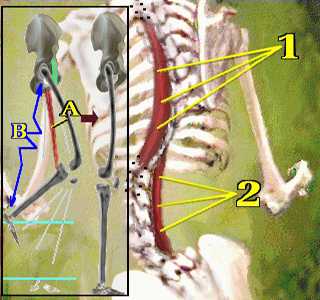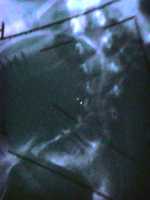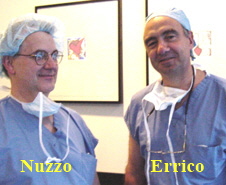
Scoliosis
and
Botulinum Toxin
Scoliosis is a side bending and twisting of the spinal column away from its correct anatomical form.
On forward bending, a twist causes some ribs to displace forward and others to displace backward so that the rib cage may not point in the same direction as the pelvis or head. The
ribs of one side may get compressed together and impair movement, which in severe cases can impair breathing as well as the function of internal organs.
Unlike so called 'Idiopathic Scoliosis' wherein the cause of asymmetrical growth is unclear, in neuromuscular diseases the causes are usually known. Patients with spasticity, for example, have an array of bodily contortions or restrictions due to limitation of range or overt contracture of specific muscle groups (see above A-B). See also a fuller discussion of scoliosis.
In patients with spasticity, it is our hypothesis that the very same problems of muscle based contracture as seen in the hands, arms, mouth, abdomen, hips, knees, and ankles, are also at work on the spine (see right 1 & 2).
The surgery rate for such 'paralytic scoliosis' is very very high. It also tends toward very
severe curves at very young ages. Surgery is frequently forced at a an age before a desired span of growth has been attained and before further growth and its strong deforming force
has dissipated. Even with the usual posterior spinal fusion, a crankshaft deformity can develop afterward.
We try to slow the progression of the spastic scoliosis deformity by weakening the muscles of the more actively contracting side of the curve. One method is the
injection into the shortened muscles of botulinum toxin, a paralyzing chemical, which can render the overactive muscles less active (by interfering with the release of neurotransmitter at the nerve muscle "endplate" where the
overactive nerve drives these muscles). Under the best of circumstances, this drug has a duration of activity of about 3 months. If it dispersed in too many places, giving each site too
low a dose, the effect will be more short-lived.
weakening the muscles of the more actively contracting side of the curve. One method is the
injection into the shortened muscles of botulinum toxin, a paralyzing chemical, which can render the overactive muscles less active (by interfering with the release of neurotransmitter at the nerve muscle "endplate" where the
overactive nerve drives these muscles). Under the best of circumstances, this drug has a duration of activity of about 3 months. If it dispersed in too many places, giving each site too
low a dose, the effect will be more short-lived.
 The injection is guided by an electrical muscle
stimulator using an insulated injection needle. That muscle which is most deforming when stimulated gets botulinum toxin.
The injection is guided by an electrical muscle
stimulator using an insulated injection needle. That muscle which is most deforming when stimulated gets botulinum toxin.
X-ray control is also used to guide the needle tip, especially to the deeper muscles, including
those near the front of the spine (psoas)
 After the
deforming forces are made less vigorous by the toxin, brace treatment is used to try to correct the posture during the period of maximum activity of the drug.
After the
deforming forces are made less vigorous by the toxin, brace treatment is used to try to correct the posture during the period of maximum activity of the drug.
In essence, the injections will be used to try to make brace treatment more effective in cases where it was unable to hold back the deformity.
Even though the drug wears off, the straighter spine may well tolerate bracing more. A straighter spine is easier to hold straight than a bent spine is to push straight. The brace that apparently failed may now work again.

 << Left a 5y/o with a steep lumbar spinal curve progressing braced.
<< Left a 5y/o with a steep lumbar spinal curve progressing braced.
Right >>
is 13 months after a single Botox treatment and reapplication of the brace.
The brace holds once the curve is made straighter allowing better application of forces and simpler forces.
There is a section on Botulinum Toxin.
See also the update: SPML of Spine


